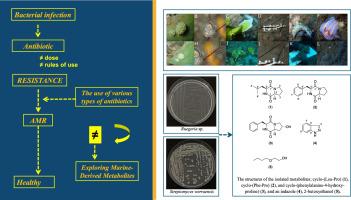Antibacterial metabolites from a heterobranchia-associated bacteria and their prey from Bali, Indonesia
IF 5.8
Q1 MICROBIOLOGY
引用次数: 0
Abstract
Marine-associated bacteria serve as a significant source of bioactive natural products for drug discovery efforts. The microbial symbionts of heterobranchs and their prey represent a promising source of bioactive compounds with potential applications as pharmaceutical agents. This study aimed to evaluate the diversity of associated microbes of heterobranchs and their prey that were obtained from one of marine biodiversity hotspots. The next step involved employing in vitro antibacterial screening of the organic extracts of the bacterial strains to determine the most potent ones. Microbiome study revealed that Hypselodoris roo had the most diverse microbiome, with Proteobacteria and Firmicutes bacterial taxa predominating among six heterobranchia samples. A total of 46 bacterial strains and 243 actinobacterial strains have been isolated from six nudibranchs and their prey sources. Next, Ruegeria sp., a symbiont from the sponge prey, exhibited the most promising antibacterial. Subsequent chromatographic purification revealed the presence of three known cyclic dipeptides: cyclo(Leu-Pro) (1), cyclo(Phe-Pro) (2), and cyclo(phenylalanine-4‑hydroxy-proline) (3), along with an indazole 4 in the extract of Ruegeria sp. All the metabolites have never been reported from this symbiont bacteria associated to the organisms examined in this study.

一种异分枝相关细菌及其猎物的抗菌代谢物,来自印度尼西亚巴厘岛
与海洋有关的细菌是药物发现工作的生物活性天然产物的重要来源。异枝共生微生物及其猎物是生物活性化合物的重要来源,具有潜在的药用价值。本研究旨在评价从海洋生物多样性热点地区之一获得的异支伴生微生物及其猎物的多样性。下一步是采用体外抗菌筛选细菌菌株的有机提取物,以确定最有效的。微生物组研究表明,Hypselodoris roo的微生物组最多样化,以变形菌门和厚壁菌门细菌类群为主。从6种裸鳃动物及其猎物中分离到46株细菌和243株放线菌。其次,来自海绵猎物的共生体Ruegeria sp.表现出最有希望的抗菌作用。随后的色谱纯化发现在Ruegeria sp.的提取物中存在三种已知的环二肽:cyclo(Leu-Pro) (1), cyclo(phep -pro)(2)和cyclo(phenylalanine-4‑羟基脯氨酸)(3),以及茚唑4。所有这些代谢产物都从未报道过与本研究中检测的生物相关的共生细菌。
本文章由计算机程序翻译,如有差异,请以英文原文为准。
求助全文
约1分钟内获得全文
求助全文
来源期刊

Current Research in Microbial Sciences
Immunology and Microbiology-Immunology and Microbiology (miscellaneous)
CiteScore
7.90
自引率
0.00%
发文量
81
审稿时长
66 days
 求助内容:
求助内容: 应助结果提醒方式:
应助结果提醒方式:


